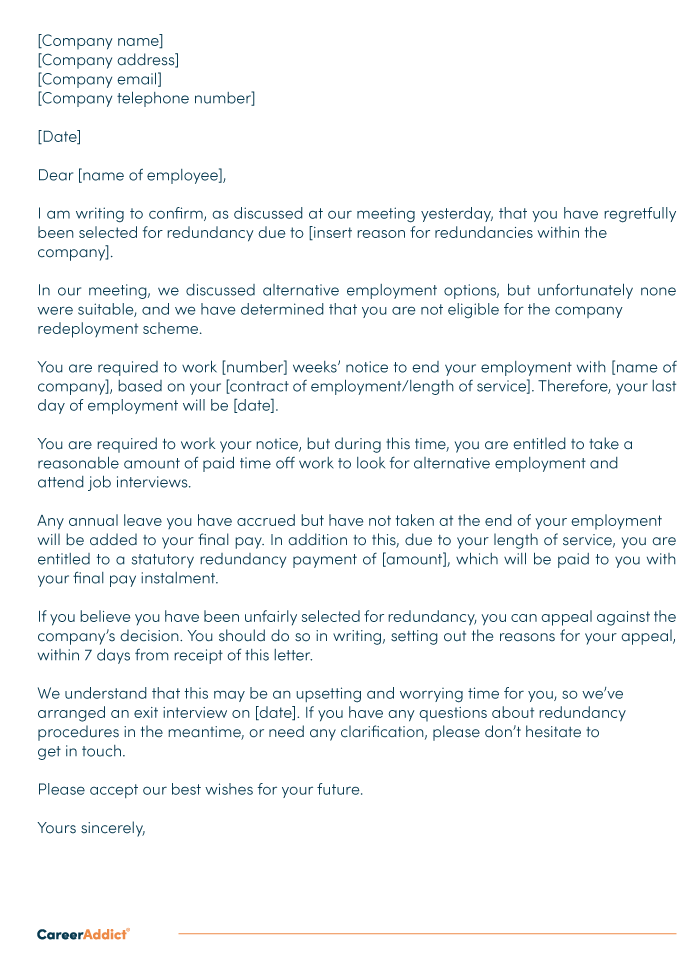If a Company Goes Bust Who Pays Redundancy? Legal Insights for UK Personnel
If a Company Goes Bust Who Pays Redundancy? Legal Insights for UK Personnel
Blog Article
Exploring the Interplay In Between Business Redundancy and Business Versatility for Future Growth
In the vibrant landscape of today's organization world, the elaborate connection between company redundancy and business flexibility arises as a vital variable for sustained growth and success. Companies typically deal with the obstacle of striking a fragile equilibrium in between maintaining a level of redundancy to reduce dangers and cultivating adaptability to respond quickly to the ever-evolving market demands.
Value of Business Redundancy
Business redundancy is a critical component that boosts organizational resilience and reduces operational risks. By incorporating redundancy measures within the organizational structure, firms can much better withstand unexpected disruptions and fluctuations in the business environment. Redundancy works as a critical barrier, permitting firms to adjust and respond effectively to unexpected obstacles without endangering necessary operations.
One key aspect of the significance of company redundancy is its duty in making sure continuity during times of situation. When confronted with sudden changes or emergency situations, repetitive systems, resources, or personnel can action in to preserve essential features and stop extensive disruptions. This connection not only safeguards the company's online reputation and client trust yet likewise minimizes economic losses and functional downtime.

Approaches for Organizational Versatility

Another important method is spending in technology and infrastructure that can support versatility and scalability. Carrying out electronic devices, automation, and information analytics can simplify procedures, boost performance, and provide useful understandings for educated decision-making. In addition, developing versatile business frameworks that permit for fast modifications to market characteristics and client requirements is vital for staying competitive in a rapidly developing environment. By proactively identifying potential disturbances and chances, organizations can proactively adapt and flourish in an ever-changing organization landscape.
Balancing Redundancy and Flexibility
Accomplishing an unified equilibrium in between operational redundancy and business adaptability is vital in browsing the complexities of a dynamic organization setting. Redundancy within a business gives view publisher site a safeguard, guaranteeing connection and stability in procedures. However, an unwanted of redundancy can cause inefficiencies and prevent adaptability to transforming market conditions. On the various other hand, organizational versatility allows firms to react immediately to external interruptions and confiscate new possibilities. Striking the best equilibrium between redundancy and versatility is a fragile procedure that needs a deep understanding of the company's goals, market characteristics, and risk resistance.
To accomplish this balance, business need to carry out normal analyses of their procedures to recognize locations where redundancy is essential for threat reduction and where versatility can browse this site drive advancement and development. Carrying out flexible structures, fostering a society of continual understanding and renovation, and motivating open communication across all levels of the company are vital methods to harmonize redundancy and adaptability effectively. By straightening these 2 important aspects, companies can Read More Here position themselves for lasting growth and success in an ever-changing company landscape.
Study on Adjustment Success
In analyzing instances of effective organizational adaptation, it comes to be obvious that the interplay in between operational redundancy and adaptability is a specifying aspect in forming resilient businesses. One engaging case research is that of Netflix. At first a DVD rental service, Netflix showed amazing flexibility by transitioning into a streaming system when digitalization interrupted the market. By strategically buying innovation and web content development, Netflix not just thrived however survived in a quickly evolving market. One more standout example is Amazon. Starting as an on-line bookstore, Amazon continually adjusted its company version, expanding right into varied industries such as cloud computing and artificial intelligence. This adaptability allowed Amazon to remain in advance of competitors and satisfy transforming consumer needs. Last but not least, Adobe offers a notable image of successful adjustment. The firm shifted from offering software program licenses to a subscription-based version, guaranteeing persisting revenue streams and enhanced client involvement. These study highlight the importance of functional redundancy paired with business flexibility in promoting long-term development and competitiveness.
Building Resilience for Future Development
Building strength for future growth calls for a calculated alignment of functional procedures with market dynamics and arising patterns. Companies need to adapt to altering environments by promoting a culture of versatility, innovation, and continual improvement.
Furthermore, cultivating strong connections with stakeholders, such as customers, workers, distributors, and the neighborhood, is essential for weathering unpredictabilities and maintaining trust and assistance throughout stormy times. Efficient interaction and transparency play an important duty in structure resilience, as they assist promote and align expectations cooperation in navigating uncertainties.
In addition, companies need to prioritize discovering and growth initiatives to upskill employees and furnish them with the needed devices to adjust to altering circumstances. By investing in their workforce, business can improve their flexibility and dexterity, inevitably reinforcing their resilience for sustainable future growth.
Conclusion

In the vibrant landscape of today's service world, the intricate connection in between company redundancy and business flexibility emerges as a critical element for continual development and success. Companies commonly encounter the challenge of striking a delicate balance in between keeping a level of redundancy to alleviate threats and fostering adaptability to react promptly to the ever-evolving market needs.To achieve this balance, business require to perform regular analyses of their operations to identify areas where redundancy is needed for threat reduction and where adaptability can drive development and growth.In final thought, the interaction in between firm redundancy and business flexibility is crucial for future growth. Building durability with a combination of redundancy and versatility will certainly make sure that firms are prepared for the obstacles of the future.
Report this page